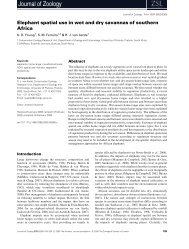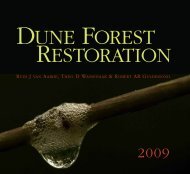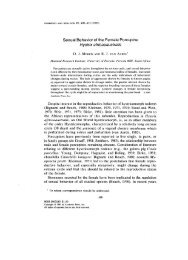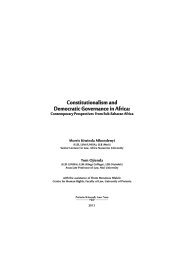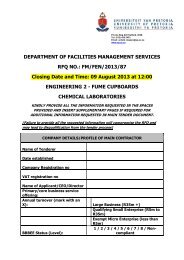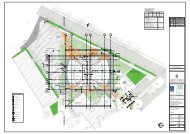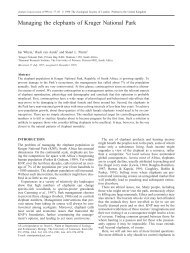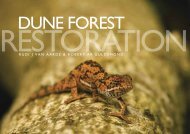Neighbourhood renewal in Cape Town's inner city: Is it gentrification?
Neighbourhood renewal in Cape Town's inner city: Is it gentrification?
Neighbourhood renewal in Cape Town's inner city: Is it gentrification?
You also want an ePaper? Increase the reach of your titles
YUMPU automatically turns print PDFs into web optimized ePapers that Google loves.
ISSN 0378-5254 Tydskrif vir Ges<strong>in</strong>sekologie en Verbruikerswetenskappe, Vol 28, 2000<br />
TABLE 3: RECLASSIFICATION RESULTS OF GROUPS AS PREDICTED BY DISCRIMINANT ANALYSIS<br />
responded w<strong>it</strong>h <strong>in</strong>ternational <strong>gentrification</strong> research<br />
f<strong>in</strong>d<strong>in</strong>gs (Lees 1994; Filion 1991; Gale 1979; Lang<br />
1981:18).<br />
The success of the discrim<strong>in</strong>ant analysis <strong>in</strong> dist<strong>in</strong>guish<strong>in</strong>g<br />
between restorers and non-restorers is <strong>in</strong>dicated <strong>in</strong><br />
the re-classification results of the procedure. Of the 293<br />
cases used <strong>in</strong> the research, 246 were classified correctly,<br />
translat<strong>in</strong>g <strong>in</strong>to a success rate of 84 % (see Table<br />
3). By us<strong>in</strong>g these 11 variables as chosen by discrim<strong>in</strong>ant<br />
analysis, a prediction as to whether a person w<strong>it</strong>h<br />
certa<strong>in</strong> characteristics would restore his property and<br />
hence could be classified as a gentrifier <strong>in</strong> <strong>Cape</strong> Town<br />
could be made w<strong>it</strong>h relative certa<strong>in</strong>ty.<br />
Gentrification profile for <strong>Cape</strong> Town<br />
The result of the discrim<strong>in</strong>ant analysis only gave a general<br />
<strong>in</strong>dication of the characteristics of restorers and<br />
non-restorers - for example, that the first-mentioned<br />
group had smaller families, higher qualifications, wh<strong>it</strong>ecollar<br />
jobs, etc., while the last group displayed the oppos<strong>it</strong>e<br />
characteristics. The 11 variables were then used to<br />
compile a <strong>gentrification</strong> profile for <strong>Cape</strong> Town, but <strong>in</strong><br />
order to use these variables <strong>in</strong> an explanatory framework,<br />
more exact quantification was needed. To create<br />
the profile for <strong>Cape</strong> Town, the averages were calculated<br />
for variables w<strong>it</strong>h <strong>in</strong>terval data. For those w<strong>it</strong>h nom<strong>in</strong>al<br />
data, cont<strong>in</strong>gency tables were constructed and the per-<br />
44<br />
Groups Number of cases<br />
Restorer 111<br />
Non-restorer 182<br />
TABLE 4: GENTRIFICATION PROFILE FOR CAPE TOWN<br />
Personal characteristics<br />
Qualification<br />
Occupation<br />
Income<br />
Family size<br />
Behaviour characteristics<br />
Contact w<strong>it</strong>h neighbours<br />
Contact w<strong>it</strong>h colleagues<br />
Purchas<strong>in</strong>g of cloth<strong>in</strong>g<br />
Property characteristics<br />
Cond<strong>it</strong>ion <strong>in</strong> the past<br />
Cond<strong>it</strong>ion now<br />
Ownership<br />
Number of bedrooms<br />
Predicted group affiliation<br />
Restorer Non-restorer<br />
93<br />
18<br />
(83,8%)<br />
(16,2%)<br />
29<br />
153<br />
(15,9%)<br />
(84,1%)<br />
Variables Gentrification characteristics<br />
Post-matric qualification<br />
Wh<strong>it</strong>e-collar job<br />
Higher than R60 000 p.a.<br />
2,9 persons<br />
No contact w<strong>it</strong>h neighbours<br />
Contact w<strong>it</strong>h colleagues<br />
CBD and other areas of <strong>c<strong>it</strong>y</strong><br />
Dilapidated cond<strong>it</strong>ion<br />
Renovated cond<strong>it</strong>ion<br />
Owner occupier<br />
2,6 bedrooms<br />
centages of respondents that did restore their properties<br />
were used as guidel<strong>in</strong>e for the profile.<br />
This manipulation of the data was used to construct a<br />
profile of a restorer or potential gentrifier for <strong>Cape</strong> Town.<br />
The personal characteristics of a person who does<br />
restore his/her hous<strong>in</strong>g un<strong>it</strong> are as follows: he/she will<br />
have a family size of 2,9 persons, a postmatric educational<br />
qualification, a wh<strong>it</strong>e-collar job and an <strong>in</strong>come<br />
higher than R60 000 per year. The behavioural characteristics<br />
of these people are that they have no contact<br />
w<strong>it</strong>h their neighbours, but do have contact w<strong>it</strong>h their<br />
colleagues. They purchase their cloth<strong>in</strong>g <strong>in</strong> the CBD<br />
and other areas of the <strong>c<strong>it</strong>y</strong>. The characteristics of the<br />
property is that the hous<strong>in</strong>g un<strong>it</strong> was <strong>in</strong> a dilapidated<br />
cond<strong>it</strong>ion <strong>in</strong> the past, but has been renovated, is owneroccupied<br />
and has an average of 2,6 bedrooms (see<br />
Table 4).<br />
These characteristics or <strong>gentrification</strong> profile for <strong>Cape</strong><br />
Town was subsequently used to determ<strong>in</strong>e whether the<br />
<strong>renewal</strong> process that is tak<strong>in</strong>g place <strong>in</strong> the <strong>c<strong>it</strong>y</strong> is actually<br />
<strong>gentrification</strong>.<br />
Gentrified areas <strong>in</strong> <strong>Cape</strong> Town<br />
A neighbourhood profile was developed for each of<br />
the six <strong>in</strong>ner-<strong>c<strong>it</strong>y</strong> areas of <strong>Cape</strong> Town that were <strong>in</strong>cluded<br />
<strong>in</strong> the study. The six neighbourhood profiles<br />
<strong>Neighbourhood</strong> <strong>renewal</strong> <strong>in</strong> <strong>Cape</strong> Town’s <strong>in</strong>ner <strong>c<strong>it</strong>y</strong>: is <strong>it</strong> <strong>gentrification</strong>?






